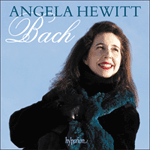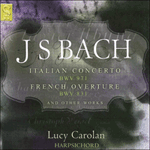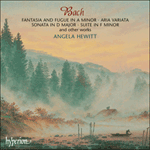BWV904 does seem like an organ piece at times. It is not hard to imagine the descending bass at the opening of the fantasia doubled by the pedals, giving it even more gravity and weight than it already has. (Some pianists try to imitate this by adding the extra octave, but this is a case where that can only be done with the addition of a lot of sustaining pedal, thus blurring the wonderful counterpoint.) It is marked alla breve and resembles the stile antico style of writing (the Baroque adaptation of Renaissance polyphony). The opening ritornello appears four times with three interspersed episodes, all emphasizing the contrapuntal nature of the piece. The fugue has two subjects: the first boldly characterized by leaps and punctuated by rests; the second a slow, descending chromatic scale that makes a dramatic appearance halfway through. They could not be more different. But that is exactly what Bach wants, especially when he combines the two in the final section. That way there are easily distinguishable. Making that audible to the listener, however, is not easy as his counterpoint in this case is awkward and doesn’t lie well under the fingers. It is thought that Bach was not responsible for placing these two movements together; in fact they don’t appear that way until early in the nineteenth century—and then only by accident. However, I don’t think we would realize this if we didn’t already know, as they make such good companions.
from notes by Angela Hewitt © 2004
La pièce, BWV904, donne vraiment parfois l’impression d’être écrite pour l’orgue. On imagine sans difficulté la basse descendante du début de la fantaisie doublée au pédalier, accentuant encore la gravité et la profondeur dont elle fait déjà preuve. (Certains pianistes, désireux d’en imiter l’effet, ajoutent une octave supplémentaire; on ne peut y parvenir qu’en se servant de la pédale «forte», noyant ainsi le merveilleux contrepoint.) Notée alla breve, elle propose une écriture ressemblant au stile antico (l’adaptation baroque de la polyphonie de la Renaissance). Le ritornello initial est reprise quatre fois tandis que les interludes accentuent à chaque fois la nature contrapuntique de la pièce. La fugue comprend deux sujets: ponctué par des silences, le premier se caractérise par des sauts audacieux tandis que le second est une gamme chromatique lente et descendante qui fait une entrée dramatique au milieu de l’œuvre. Ils ne pourraient être plus différents l’un de l’autre. Et c’est exactement ce que Bach veut, en particulier lorsqu’il les associe dans la section finale. De cette manière, on peut facilement les reconnaître. Pourtant, il n’est guère aisé de les faire d’emblée percevoir d’emblée à l’auditeur, car ce contrepoint est ardu. Il ne tombe pas facilement sous les doigts. A l’heure actuelle, on considère que ce n’est probablement pas Bach qui a réuni ces deux mouvements. Ils n’apparaissent ensemble que depuis le début du XIXe siècle – encore est-ce seulement par hasard. Pourtant, je pense que, à moins de le savoir à l’avance, on ne peut s’en rendre compte tant ils sont parfaitement assemblés.
extrait des notes rédigées par Angela Hewitt © 2004
Français: Isabelle Battioni
Das Werk, BWV904, scheint zumeist wirklich ein Orgelwerk zu sein. Es ist gut denkbar, dass die absteigende Basslinie am Anfang der Fantasia vom Pedal verdoppelt wird, um ihr noch mehr Gravitas zu verleihen, als sie ohnehin schon besitzt. (Einige Pianisten versuchen, diesen Effekt auf dem Klavier zu imitieren, indem sie eine Oktave hinzufügen; in diesem Falle ist dies jedoch nur mit Hilfe des rechten Pedals möglich, was wiederum den wunderbaren Kontrapunkt zudeckt.) Das Stück ist mit Alla breve überschrieben und ähnelt dem stile antico (die barocke Interpretation der Polyphonie der Renaissance). Das Ritornello am Anfang erscheint insgesamt viermal, alternierend mit drei Zwischenspielen, was die kontrapunktische Natur des Stückes verdeutlicht. Die Fuge hat zwei Themen: das erste zeichnet sich durch kühne Sprünge aus, die von Pausen unterbrochen werden; das zweite besteht aus einer langsamen, absteigenden chromatischen Tonleiter, die nach etwa der Hälfte einen dramatischen Auftritt hat. Die beiden Themen könnten unterschiedlicher nicht sein und es ist dies genau Bachs Absicht, besonders wenn er in der Schlusspassage beide miteinander kombiniert. Dadurch sind sie gut voneinander zu unterscheiden. Es ist jedoch nicht leicht, dies für den Hörer deutlich zu machen, da der Kontrapunkt stakig daherkommt und nicht gut in den Fingern liegt. Es wird angenommen, dass Bach diese beiden Sätze nicht selbst zusammengefügt hat; tatsächlich erscheinen sie erst im 19. Jahrhundert als ein Paar—und dies völlig unbeabsichtigt. Ich bin jedoch der Ansicht, dass dies nicht auffallen würde, wenn es nicht bekannt wäre, da die beiden Stücke so gut zueinander passen.
aus dem Begleittext von Angela Hewitt © 2004
Deutsch: Viola Scheffel


 Bach: Angela Hewitt – The Bach Recordings
Bach: Angela Hewitt – The Bach Recordings Bach: Angela Hewitt plays Bach
Bach: Angela Hewitt plays Bach Bach: Italian Concerto & French Overture
Bach: Italian Concerto & French Overture Bach: Fantasia, Aria & other works
Bach: Fantasia, Aria & other works
